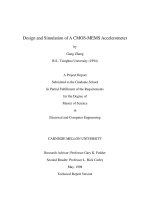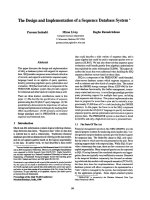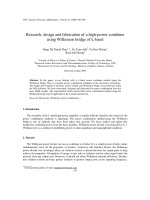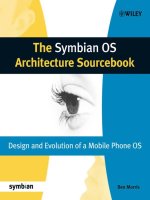the symbian os architecture sourcebook design and evolution of a mobile phone os
Bạn đang xem bản rút gọn của tài liệu. Xem và tải ngay bản đầy đủ của tài liệu tại đây (3.94 MB, 633 trang )
The Symbian OS
Architecture
Sourcebook
The Symbian OS
Architecture
Sourcebook
Design and Evolution of a Mobile
Phone OS
By
Ben Morris
Reviewed by
Chris Davies, Warren Day, Martin de Jode, Roy Hayun,
Simon Higginson, Mark Jacobs, Andrew Langstaff, David
Mery, Matthew O’Donnell, Kal Patel, Dominic Pinkman,
Alan Robinson, Matthew Reynolds, Mark Shackman,
Jo Stichbury, Jan van Bergen
Symbian Press
Head of Symbian Press
Freddie Gjertsen
Managing Editor
Satu McNabb
Copyright 2007 Symbian Software, Ltd
John Wiley & Sons, Ltd The Atrium, Southern Gate, Chichester,
West Sussex PO19 8SQ, England
Telephone (+44) 1243 779777
Email (for orders and customer service enquiries):
Visit our Home Page on www.wileyeurope.com or www.wiley.com
All Rights Reserved. No part of this publication may be reproduced, stored in a retrieval system or
transmitted in any form or by any means, electronic, mechanical, photocopying, recording, scanning or
otherwise, except under the terms of the Copyright, Designs and Patents Act 1988 or under the terms of
a licence issued by the Copyright Licensing Agency Ltd, 90 Tottenham Court Road, London W1T 4LP,
UK, without the permission in writing of the Publisher. Requests to the Publisher should be addressed to
the Permissions Department, John Wiley & Sons Ltd, The Atrium, Southern Gate, Chichester, West
Sussex PO19 8SQ, England, or emailed to , or faxed to (+44) 1243 770620.
Designations used by companies to distinguish their products are often claimed as trademarks. All
brand names and product names used in this book are trade names, service marks, trademarks or
registered trademarks of their respective owners. The Publisher is not associated with any product or
vendor mentioned in this book.
This publication is designed to provide accurate and authoritative information in regard to the subject
matter covered. It is sold on the understanding that the Publisher is not engaged in rendering
professional services. If professional advice or other expert assistance is required, the services of a
competent professional should be sought.
Other Wiley Editorial Offices
John Wiley & Sons Inc., 111 River Street, Hoboken, NJ 07030, USA
Jossey-Bass, 989 Market Street, San Francisco, CA 94103-1741, USA
Wiley-VCH Verlag GmbH, Boschstr. 12, D-69469 Weinheim, Germany
John Wiley & Sons Australia Ltd, 42 McDougall Street, Milton, Queensland 4064, Australia
John Wiley & Sons (Asia) Pte Ltd, 2 Clementi Loop #02-01, Jin Xing Distripark, Singapore 129809
John Wiley & Sons Canada Ltd, 6045 Freemont Blvd, Mississauga, Ontario, L5R 4J3, Canada
Wiley also publishes its books in a variety of electronic formats. Some content that
appears in print may not be available in electronic books.
Anniversary Logo Design: Richard J. Pacifico
Library of Congress Cataloging-in-Publication Data
Morris, Ben, 1958-
The Symbian OS architecture sourcebook : design and evolution of a
mobile phone OS / by Ben Morris.
p. cm.
Includes bibliographical references.
ISBN-13: 978-0-470-01846-0
ISBN-10: 0-470-01846-1
1. Operating systems (Computers) 2. Symbian OS (Computer file) I.
Title.
QA76.76.O63M6835 2007
005.4
32 – dc22
2006103533
British Library Cataloguing in Publication Data
A catalogue record for this book is available from the British Library
ISBN: 978-0-470-01846-0
Typeset in 10/12pt Optima by Laserwords Private Limited, Chennai, India
Printed and bound in Great Britain by Bell & Bain, Glasgow
This book is printed on acid-free paper responsibly manufactured from sustainable
forestry in which at least two trees are planted for each one used for paper production.
To Philippa, with love.
Contents
About this Author xiii
Acknowledgements xv
Glossary of Terms xvii
Introduction xix
Part 1: The Background to Symbian OS
1 Why Phones Are Different 3
1.1 The Origins of Mobile Phones 3
1.2 From 2G to 3G 5
1.3 Mobile Phone Evolution 6
1.4 Technology and Soft Effects 7
1.5 Disruption and Complexity 9
1.6 The Thing About Mobile Phones 10
2 The History and Prehistory of Symbian OS 15
2.1 The State of the Art 15
2.2 In the Beginning 17
2.3 The Prehistory of Psion 20
2.4 The Beginnings of Symbian OS 22
2.5 The Mobile Opportunity 26
2.6 Background to the First Licensee Projects 27
2.7 Device Families 31
2.8 Operating System Influences 37
viii CONTENTS
3 Introduction to the Architecture
of Symbian OS 45
3.1 Design Goals and Architecture 45
3.2 Basic Design Patterns of Symbian OS 49
3.3 Why Architecture Matters 49
3.4 Symbian OS Layer by Layer 52
3.5 The Key Design Patterns 56
3.6 The Application Perspective 65
3.7 Symbian OS Idioms 71
3.8 Platform Security from Symbian OS v9 83
4 Introduction to Object Orientation 87
4.1 Background 87
4.2 The Big Attraction 88
4.3 The Origins of Object Orientation 90
4.4 The Key Ideas of Object Orientation 92
4.5 The Languages of Object Orientation 100
Part 2: The Layered Architecture View
5 The Symbian OS Layered Model 111
5.1 Introduction 111
5.2 Basic Concepts 111
5.3 Layer-by-Layer Summary of the Symbian OS v9.3
Model 117
5.4 What the Model Does Not Show 119
5.5 History 119
6 The UI Framework Layer 121
6.1 Introduction 121
6.2 Purpose 122
6.3 Design Goals 123
6.4 Overview 123
6.5 Architecture 124
6.6 A Short History of the UI Architecture 128
6.7 Component Collections 129
7 The Application Services Layer 133
7.1 Introduction 133
7.2 Purpose 134
7.3 Design Goals 134
7.4 Overview 135
7.5 Legacy Application Engines 137
7.6 Architecture 137
7.7 Component Collections 149
CONTENTS ix
8 The OS Services Layer 165
8.1 Introduction 165
8.2 Purpose 166
8.3 Design Goals 168
8.4 Overview 170
8.5 Architecture 171
8.6 Generic OS Services Block 171
8.7 Multimedia and Graphics Services Block 177
8.8 Connectivity Services Block 192
9 The Comms Services Block 199
9.1 Introduction 199
9.2 Purpose 201
9.3 Design Goals 204
9.4 Overview 206
9.5 Architecture 206
9.6 Comms Framework 210
9.7 Telephony Services 220
9.8 Networking Services 230
9.9 Short-link Services 245
10 The Base Services Layer 255
10.1 Introduction 255
10.2 Purpose 255
10.3 Design Goals 256
10.4 Overview 257
10.5 Architecture 258
10.6 Component Collections 270
11 The Kernel Services and Hardware Interface
Layer 279
11.1 Introduction 279
11.2 Purpose 280
11.3 Design Goals 281
11.4 Overview 283
11.5 EKA1 and EKA2 283
11.6 Singleton Component Collections 284
11.7 Kernel Architecture Block 285
11.8 Kernel Architecture Component Collections 295
12 The Java ME Subsystem 301
12.1 Introduction 301
12.2 Requirements of the Java ME Subsystem 302
12.3 Design Goals for the Java ME Subsystem 302
12.4 Evolution of Java on Symbian OS 303
xCONTENTS
12.5 Architecture 306
12.6 Component Collections 311
13 Notes on the Evolution of Symbian OS 319
13.1 The State of the Art 319
13.2 Summary of Symbian OS v6 Releases 319
13.3 Summary of Symbian OS v7 Releases 321
13.4 Summary of Symbian OS v8 Releases 324
13.5 Summary of Symbian OS v9 Releases 326
Part 3: Design Case Studies
14 The Use of Object-oriented Design
in Symbian OS 333
14.1 Introduction 333
14.2 Pioneering the Object Approach in Psion 334
14.3 A Thoroughly Object-oriented Operating System 353
15 Just Add Phone 367
15.1 Introduction 367
15.2 Anatomy of a Phone 367
15.3 The Phone Operating System 368
15.4 Telephony 378
15.5 Messaging: It’s Different on a Phone 386
16 One Size Does Not Fit All: The Radical User
Interface Solution 397
16.1 Introduction 397
16.2 Background to the Eikon GUI 402
16.3 Eikon Design Point 404
16.4 The Device Family Strategy 410
16.5 Quartz 416
16.6 Pearl 417
16.7 Nightingale 418
16.8 How to Develop a World-class GUI 420
16.9 Symbian OS User Interface Architecture 425
16.10 Future Directions 426
17 System Evolution and Renewal 429
17.1 Introduction 429
17.2 Design Lifetime 430
17.3 Renewal in Symbian OS 434
17.4 Evolution in the Kernel 436
17.5 Telephony Evolution 440
17.6 Sound and Vision Evolution 443
CONTENTS xi
17.7 Defining the Skin 444
17.8 Moving Towards Standard C++ 446
18 Creative Zoo or Software Factory? 453
18.1 Introduction 453
18.2 The Software Problem 453
18.3 Too Many Dragons 455
18.4 Software Development Approaches 456
18.5 What Making Software Is Really About 459
Appendix A: Symbian OS Component Reference 475
Appendix B: Interviewee Biographies 573
References 579
Index 583
About the Author
Ben Morris joined Psion Software in October 1997, working in the
software development kit team on the production of the first C++ and
Java SDKs for what was at that time still the EPOC32 operating system. He
led the small team that produced the SDKs for the ER5 release of EPOC32
and, when Psion Software became Symbian, he took over responsibility
for expanding and leading the company’s system documentation team.
In 2002, he joined the newly formed System Management Group in the
Software Engineering organization of Symbian, with a brief to ‘define
the system’. He devised the original System Model for Symbian OS and
currently leads the team responsible for its maintenance and evolution.
He can be found on the Internet at
www.benmorris.eu
Acknowledgements
Some people told me it would be hard to write this book in and around
my real job in the System Management Group at Symbian and a few
promised me that it would be impossible. They were all right, of course,
although none of them tried to stop me.
Many thanks to Wiley and Symbian Press therefore for their patience
as I’ve stretched deadlines. Thanks to Fredrik Josephson for saying ‘yes’
to my starting the book as a 10% task and for turning a blind eye when
it grew beyond that; and to Geert Bollen for being (almost) tolerant when
he inherited the problem. Thanks to Freddie Gjertsen of Symbian Press
for getting me to the end and to Phil Northam for his part in making it
happen in the first place.
My biggest thanks, though, are due to those who took the time to talk
to me, agreed to my using a recording device and let me use their words.
They are: Geert Bollen, Martin Budden, Andy Cloke, Charles Davies, Bob
Dewolf, Morgan Henry, lan Hutton, Peter Jackson, Keith de Mendonca,
Will Palmer, Howard Price, Murray Read, Martin Tasker, Andrew Thoelke
and David Wood. I have done my best to make sure they are happy with
the use to which I have put their words.
I am also very grateful to my technical reviewers from across the
company (and, in a few cases, from outside it): Jan van Bergen, Chris
Davies, Warren Day, Roy Hayun, Simon Higginson, Mark Jacobs, Martin
de Jode, Andrew Langstaff, David Mery, Matthew O’Donnell, Kal Patel,
Dominic Pinkman, Matt Reynolds, Alan Robinson, Mark Shackman, Phil
Spencer, and Jo Stichbury. Jeff Lewis provided a final review from a
commercial perspective.
Any errors which remain are mine, of course.
A special thanks to Jawad Arshad for his help in constructing the
reference material in Appendix A, and for his careful review of what
xvi ACKNOWLEDGEMENTS
I did with it, and to Bob Rosenberg for his great work on the System
Model graphics (which is present in the book in the form of the color
pull-out). Way back when, Martin Hardman was my original collaborator
on early versions of the System Model, and I would like to acknowledge
his contribution
Finally, my family have put up with this book for longer than was
promised. Philippa, Nat, Jake and Henrietta – thanks.
Glossary of Terms
ABI Application binary interface
ADT Abstract data type
BAL Bearer Abstraction Layer
BIO Bearer-independent object
CDMA Code Division Multiple Access
DFRD Device family reference design
DRM Digital rights management
DSP Digital Signal Processor
EDGE Enhanced Data Service for GSM Evolution
ETSI European Telecommunications Standards
Institute
FOMA Freedom of Mobile Access
GPRS General Packet Radio Service
IPC Interprocess communication
MOAP Mobile Application Platform
MTM Message type module
MVC Model–view–controller
OBEX IrDA Object Exchange
OMA Open Mobile Alliance
OTA Over the air
PAN Personal Area Networking
PIM Personal information manager
PLP Psion Link Protocol
QoS Quality of Service
RTOS Real-time operating system
RTP Real-time transport protocol
SIP Session initiation protocol
xviii GLOSSARY OF TERMS
SMIL Synchronized Multimedia Integration
Language
UART Universal Asynchronous
Transmitter/Receiver
UMTS Universal Mobile Telecommunications
System
VoIP Voice over IP
VPN Virtual Private Network
WAP Wireless Application Protocol
WDP Wireless Datagram Protocol
XIP Execute in place
Introduction
This book is part description, part reference, part case study and part
history. My goal in writing it has been to try to make Symbian OS more
accessible to a wider audience than has been catered for to date. I hope
there is nothing dumbed-down about this book, but at the same time
I have tried to make it accessible to those who are interested, but not
expert, in the topics it covers, as well as useful to a more hands-on
developer audience.
As Symbian OS becomes more mainstream – a volume product and
not just a niche one – I hope this book will serve as a primer for the
curious and a way in to a deeper understanding of what Symbian OS is,
where it came from and why it is currently riding high.
Certainly there is material here which is useful to Symbian OS devel-
opers – both seasoned and novice – and which has previously been hard
to find. However, this book takes a different approach to that of most
Symbian Press books; it is not so much a ‘how to’ book as a ‘what and
why’ book (and to some extent also a ‘who and when’ book).
Part 1 is a Symbian OS primer, a rapid introduction that sketches
the background of the mobile telephony market, traces the emergence of
Symbian OS and Symbian the company, conducts a rapid tour of the archi-
tecture of Symbian OS, and provides a refresher – or introduction – to the
key ideas of object orientation (OO) in software.
Part 2 begins the more detailed exploration of the architecture of
Symbian OS, following the Symbian OS System Model layering to provide
a complete, high-level, architectural description of Symbian OS.
Part 3 returns to the historical approach of the primer chapters, and
presents five case studies, each exploring some aspect of Symbian OS, or
of its history and evolution, in depth. Drawing on the insights – and the
xx INTRODUCTION
recollections – of those who were involved, these studies trace and try to
understand the forces that have shaped the operating system.
Appendix A contains a component by component reference, ordered
alphabetically by component name, which is definitely intended for a
developer audience. It also includes a color pull-out of the System Model
for the current public release, Symbian OS v9.3.
Who This Book Is For
This book is for anyone who wants to understand Symbian OS bet-
ter – what Symbian OS is, why it is what it is, and how it got to be that
way. If you work with Symbian OS, or intend to, this book is for you. If
you want to get under the skin of the OS and understand it more deeply,
this book is very definitely for you. This book is for you too if you are
interested in the software or mobile phone industries more generally, or
in the perennial themes of software development, or are merely curious
about how real systems get made and evolve.
A reasonable degree of software technical literacy is assumed, but not
so much that the more casual reader should shy away. There are no
exercises. And there is no sample code.
How to Use This Book
This book calls itself a
sourcebook
and it is intended to be used both as a
primer and as a reference. Its different sections are useful in their different
ways as reference material. Both Part 1 and Part 3 are structured as a
straight-through read and, I hope, they offer a good starting point from
which to come to Symbian OS for the first time. The material in Part 2
is probably deeper than a non-developer audience needs. And while this
is not (strictly) a programming book, I hope that Symbian OS developers
find its reference material useful, or better.
Telling Stories
Someone else wrote the phrase before I did: ‘‘In every great software
product is a great story’’ [McCarthy 1995]. I think it’s true. So while
this book is aimed at a technically aware audience, it is not addressed
exclusively to an audience of programmers. I hope programmers and,
more generally, software developers, designers and architects will find it
useful, especially those coming new to the OS and trying to understand
it. But I hope it will be just as useful to academics and students,
marketeers, technical decision makers and managers seeking to evaluate
INTRODUCTION xxi
and understand Symbian OS, and indeed anyone else who is broadly in
the business of software or phones or who is just interested in such things,
and who is encountering Symbian OS (or its close competitors) for the
first time and needs to understand it. Speaking personally, I have long
been something of an operating system junkie; to some extent, therefore,
this book attempts to scratch that itch. (You can’t work for an operating
system company and not have a bit of the operating system junkie in you.)
I hope that understanding the deeper story behind Symbian OS will
help those who want to (or have to) work with it to understand it better
and more deeply. Above all, I hope it will help them work better with
Symbian OS than would be the case without this book.
I have another purpose too. One of the things which appealed to me
most in my early days in the company (which became Symbian a few
months after I joined) was the degree to which everyone involved in
creating the system shared the sense that making software is a visionary
activity and that making good software, indeed the best possible soft-
ware, is as much a moral imperative as a business one. For an activity
which likes to count itself as a branch of engineering, the number, and
variety, of value words which cropped up in any daily conversation
could be surprising. Making software, which is to say making this soft-
ware in particular, is value-laden. ‘Delight’, ‘elegance’, ‘trust’, ‘integrity’,
‘robustness’, ‘reliability’, ‘economy’ and ‘parsimony’ were all among the
company buzzwords and very much part of the fabric of the effort, and
give a flavor of those times. Above all, to be part of the effort to create
Symbian OS was to be part of the revolution, no less. The truly personal,
individual, pocketable, always-on, human-scaled device you could trust
your data to, and to some extent therefore also your identity, and your
heart as well as your head, was not yet the commonplace thing which the
mobile phone revolution has made of it. Symbian – the operating system
and the company – has played its part, too, in that revolution.
Symbian is currently riding high. Symbian OS has done more than find
a niche; it has found (and, indeed, it has founded) a global market and has
led that market from its inception. To make that point more concretely,
consider this: when I was starting work on this book, I drafted a paragraph
about 2005 being a watershed year for Symbian OS, potentially its
breakout year. Between then and now, as I write this at the end of 2006,
the number of shipped Symbian OS phones has doubled from 50 million
to 100 million, and counting.
Way back when, the company was a company of individuals – who
could be opiniated, strident and arrogant but could just as quickly switch
to humility in the face of a powerful intellectual argument. Inevitably,
some of that individuality has been lost with success and growth. I hope
that by capturing some of the flavor of those times, that particular flame
can be kept burning.
xxii INTRODUCTION
I have been mindful both of commercial and personal confidences
and I believe that nothing I have written (or quoted) breaches either.
(Any instances of ‘Don’t quote me!’ which appear in the text have been
carefully approved.)
I have tried everywhere to observe the mantra ‘Tell no lies’, which
is not always the case in books such as this, and which here and there
has not been easy. Let me quote Bjarne Stroustrup as one inspiration for
honesty, ‘I abhor revisionist history and try to avoid it’.
1
I have done my
best to follow that example.
Getting Symbian OS
Anyone, anywhere, can download Symbian OS in a form in which they
can learn to program it, work with it, explore it and experiment with it.
Anyone can learn to write Symbian OS applications: development kits
are free, and easily available, for UIQ and S60 platforms; development
tools (GCC and Eclipse) are free; the Symbian Press programming books
are widely available; and the possible languages range from OPL (which
began life as the Psion Organiser Language and is now an open-source,
rapid application development language for phones based on Symbian
OS) and Visual Basic (available from AppForge), through Java and Python,
to full-on native Symbian OS C++. The range is covered, in other words,
for everyone from the hobbyist to the enterprise developer to phone
manufacturers and commercial developers.
1
In [Stroustrup 1994, p2].









